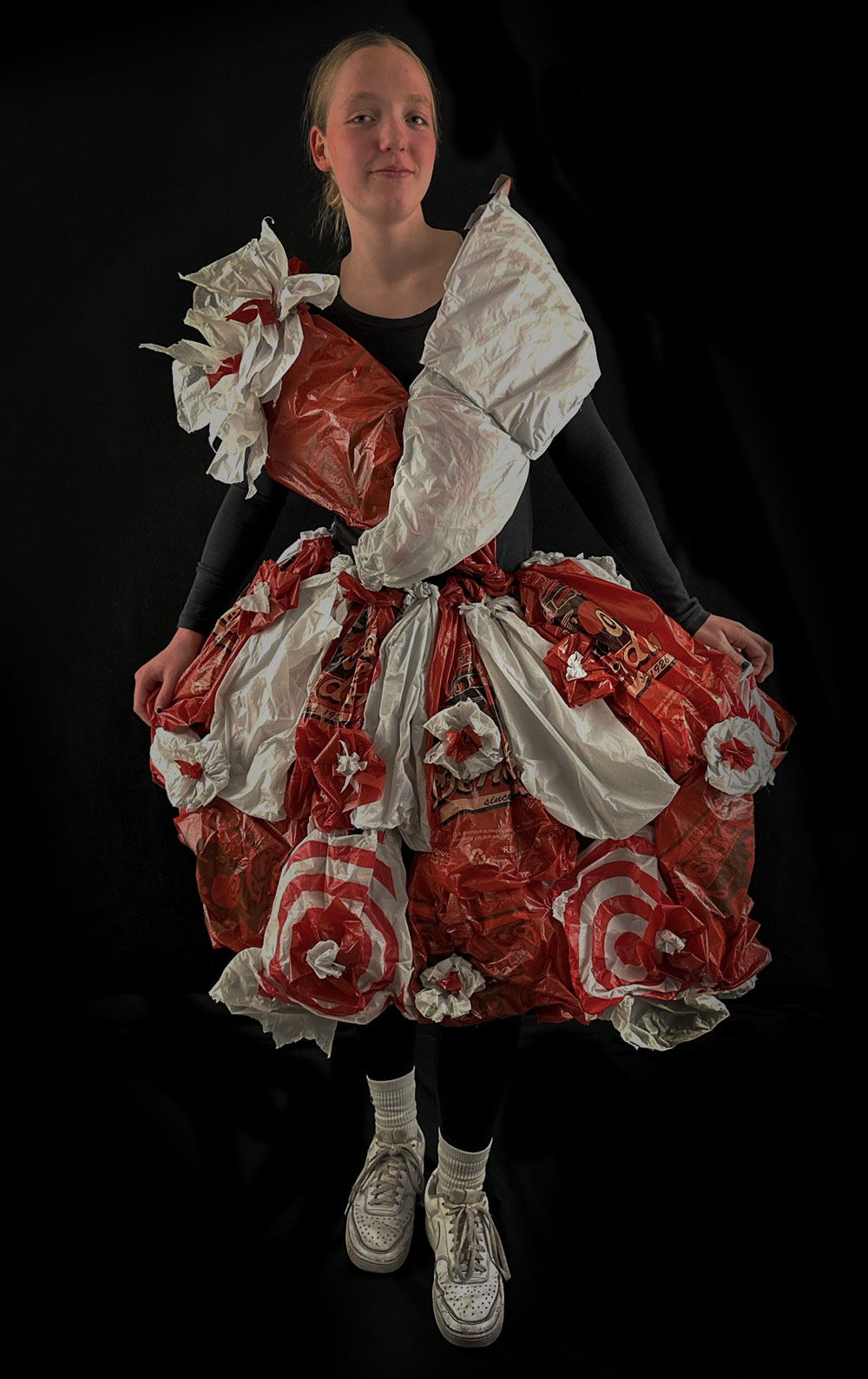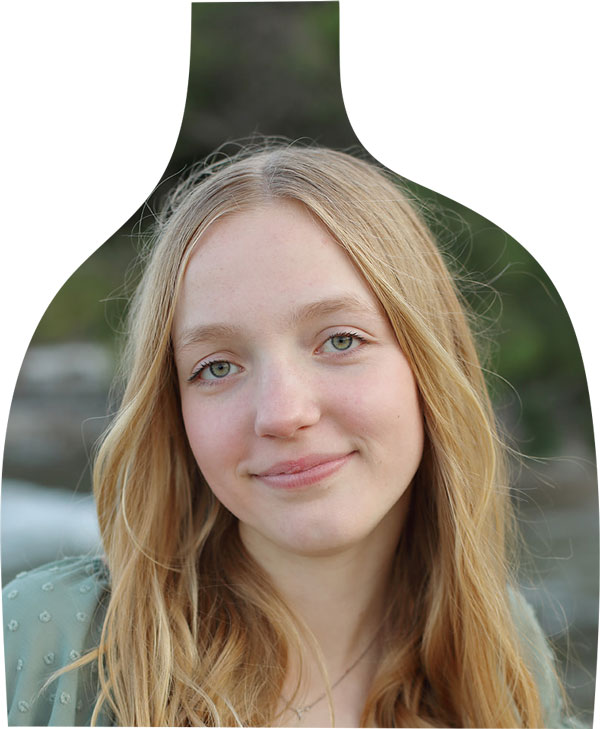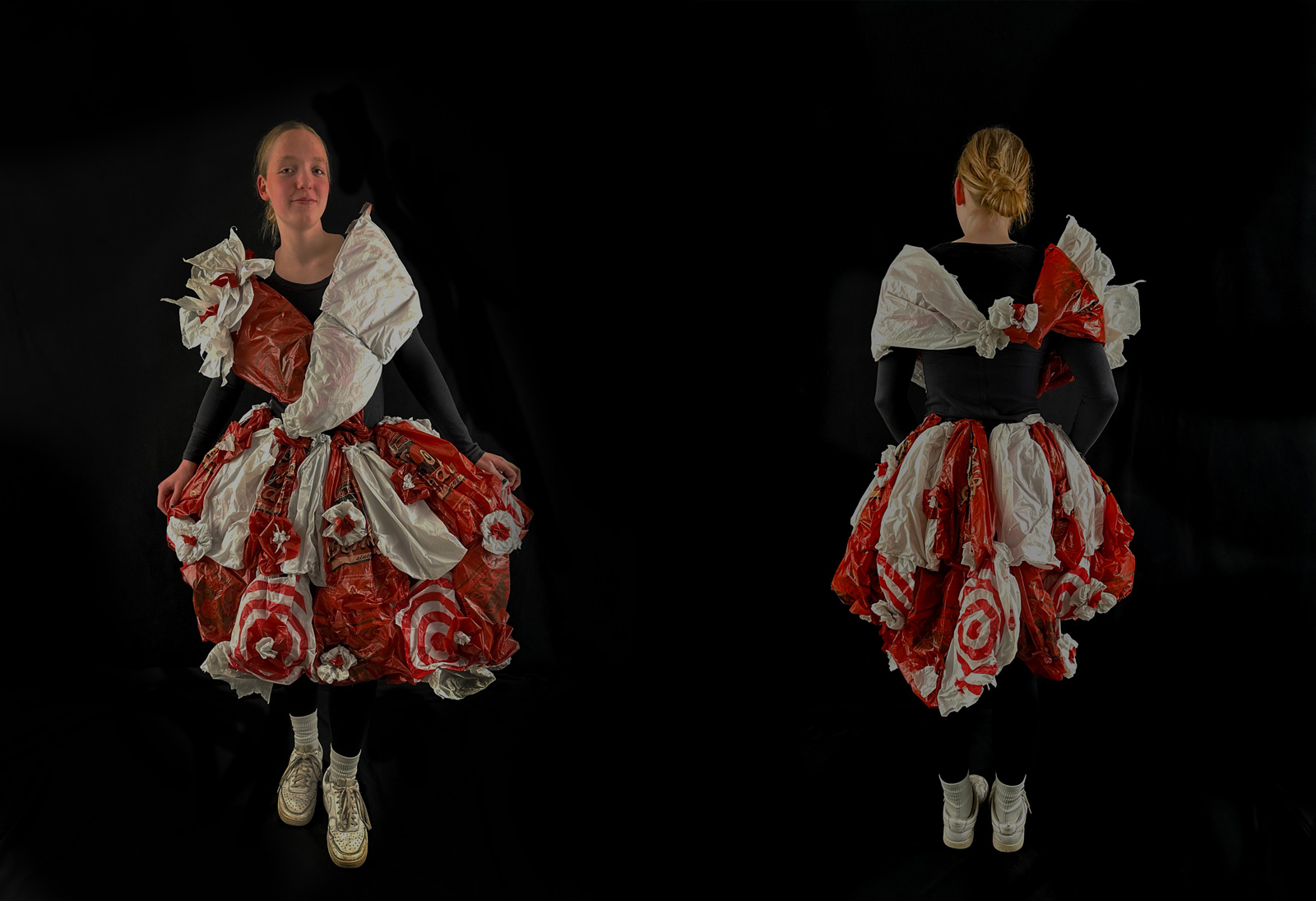

Reduce, Reuse, Recycle

Height: 40" x Width: 12" x Depth: 4' | Material(s): Plastic bags, wire, string, Velcro, hot glue | Process(es): I cut bags and glued them together in a dress form, then tied and scrunched the sides up with string. | Idea(s): Creating a constricting, tight dress to represent the control put on women and other minorities | Curatorial Note: Innovative use of materials and effective use of conceptual ideation.
Anna Miler


AP 3-D
Pius XI Catholic High School, Milwaukee, WI, USA
Enrolled in Johns Hopkins University in Baltimore, Maryland
Student statement
Student statement
Does your work reference or draw on a contemporary or historical art-making style, practice, or tradition? If so, please explain.
My work was more in a contemporary style. I aimed to create wearable sculptures that represented social issues using found objects. Instead of drawing from a specific practice or method of art making, I drew on my own creativity and passion to create something I could physically wear, without needing sewing skills.
What did you do to improve your 2-D, 3-D, or Drawing portfolio skills?
To improve my 3-D portfolio skills, I continued experimenting with my processes and materials. You must practice your skills consistently in order to get closer to mastery, and that's exactly what I did. I kept searching for more unique materials or different social issues to spark my creativity and maintain momentum in this process. For this piece, I dug through my house for inspiration, ultimately coming upon piles of plastic bags that had been saved but had yet to be used. I also sought feedback from everyone I could—peers, teachers, and even my own family—to get advice on what I could change in my piece.


How can we create wearable sculptures that bring awareness to social issues through the use of unconventional objects found in everyday life? I'm investigating issues surrounding feminism, the environment, technology, and other important matters that come up in my own personal life. I chose the materials because of the baggage that they bring with them, my materials ultimately driving my process.
Describe the critique practices and feedback you received in AP Art and Design.
Critiques and feedback were integral to my growth as an artist. The critique practice consisted of both formal and informal discussions with my peers and teachers. They often provided feedback that focused on my technique, effectiveness of the materials that I used, and my craftsmanship. A lot of the feedback was guided by specific prompts or criteria set by my teachers, which then helped focus the critiques I received. I often was encouraged to consider how well my work conveyed the social issue that I was trying to address, and whether the materials I used supported that concept. For this dress, I focused on pollution and the various ways humans contribute to climate change, specifically the excessive use of plastic bags. Instead of creating a piece with a negative outlook, I wanted to look at the positive by repurposing the bags into a dress. Some of the feedback I got on this dress that helped me further this idea along was to alter the bags more so that they became less like bags, and to make the dress more Victorian-like. As a result, I created the top of the dress without the logos and puffed up the bottom of the dress with extra bags and string.
How did your classmates help you in the creative process?
My classmates played a vital role in my creative process. Whether they were providing me feedback, helping me through my artist's block, or simply being there to talk to when I needed a break from art, they were always supportive. They were also incredibly helpful when it came to brainstorming new social issues to focus on or material ideas. They would even bring me items they had found or offer extra materials when I ran out, helping me finish my piece.
Catherine Burnett
AP Art Teacher/Fine Arts Division Head
Pius XI Catholic High School, Milwaukee, WI, USA
Teacher statement
Teacher statement
The AP Art and Design course supports inquiry-based personalized learning in the sustained investigation portfolio component. What strategies helped you guide students through inquiry?
Initially, we focus on identifying patterns and potential directions in a student’s previous work. Through critiques and one-on-one discussions, we collaborate with the student to develop and refine ideas, ultimately helping them identify their sustained investigation. Anna had taken fashion and fibers junior year, where she began exploring connections between form, materials, and content. In her AP course, we used prompts to guide her inquiry and deepen her exploration within her sustained investigation.
How did you scaffold writing into the art-making and thinking processes?
Students need enough completed artwork to begin to reflect on what the work is communicating and the possible directions it can take. In 3D we have students pay attention to how materials drive the form and inform the meaning of their work. Students free write in response to their own work and keep notes documenting their thoughts and processes. We use some of the AP videos to help clarify what AP is looking for in the writing component. We teach a writing workshop to help students refine their ideas and avoid common cliche's when writing about art. As they continue making art throughout the year, their sustained investigation writing evolves, becoming more focused and specific.
How did you support skill development AND inquiry in the AP Art and Design curriculum?
We have a 4 year sequential curriculum that provides a base of technical and conceptual thinking skills for students taking AP. Throughout our process we aim to have students make artwork that is personal and relevant to them. We facilitate any new skill building processes with students based on their individual needs or what the class needs to move them forward as a group.Through critique we teach students how to talk about their work, give constructive feedback to their peers and ideate possibilities for moving their work forward. Our AP students are required to take a contemporary art history class in the fall to expand their understanding of what art is, expose them to art, artists, new ideas and processes and the language of art.
What formative and summative assessments helped guide your students through your AP Art and Design curriculum?
Formative assessments involve ongoing one-on-one conversations with students to discuss what is working, what isn’t, and why. Summative assessments take the form of whole-class critiques, where students present their work, share insights into their sustained investigations, and explain how they addressed the prompts related to their investigation. After a summative critique, students have the opportunity to revise their work based on feedback.
What creative programming (i.e., exhibit spaces, mentoring programs, curricular supports) have you implemented to support AP Art and Design students?
A key strength of our program is that it is team-taught, enabling us to provide individualized support and personalized guidance for each student’s portfolio. AP students are also given their own wall or studio space for the year, allowing them to work independently whenever they have free time during the school day. Additionally, we offer a week-long AP summer portfolio preparation intensive class and keep the studio open one night each week to provide extended opportunities for students to work on their projects.
Anna Miler
